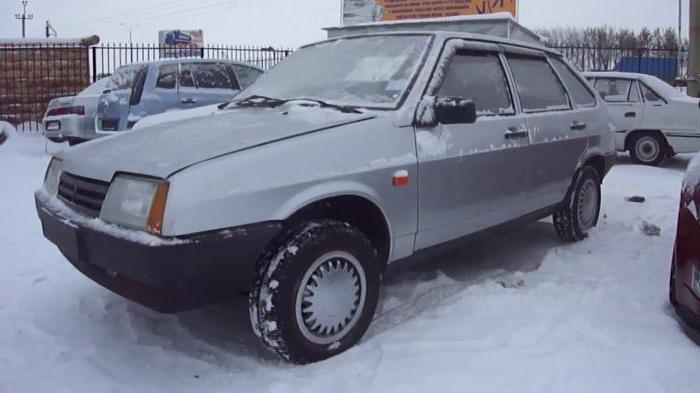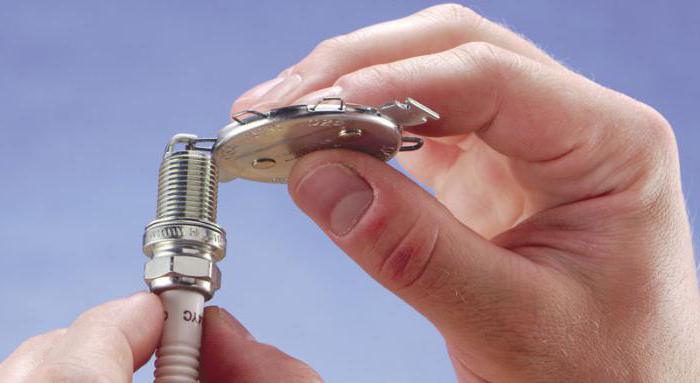The ignition system of the VAZ 2109 carburetor engine is quite simple, so it practically does not have critical malfunctions. And those malfunctions that sometimes happen can be fixed on their own without any problems. In this article, we will talk about the reasons why the spark on the VAZ 2109 (carburetor) disappears, and also consider methods for eliminating them.
Symptoms
Malfunctions of the ignition system are manifested by unstable engine operation or its complete stop and inability to start. In the first case, the power indicators of the motor are significantly reduced, the fuel consumption increases, the color of the exhaust changes, and vibration appears.
Such symptoms may indicate that no combustion of fuel occurs in one of the combustion chambers, or that the spark generated on the electrodes of one or more candles is not able to ignite it. In the second case, when the engine does not start at all, most likely there is a malfunction of one of the main elements of the system. It most often leads to the fact that the spark disappears on the VAZ 2109 (carburetor).
Carburetor engine ignition system
All "nines" from the factory are equipped with a contactless ignition system. Structurally, it consists of the following elements:
- ignition switch;
- high voltage coils;
- the switch;
- ignition distributor with Hall sensor;
- four high voltage wires;
- spark plugs.
In the event of a malfunction of any of the first four elements, the ignition system stops working and engine starting becomes impossible. Correct the situation by diagnosing and repairing the breakdown.
How does the ignition system of a carburetor VAZ 2109
To understand why the spark on the VAZ 2109 (carburetor) disappears, let's look at how its ignition system works. Let's start from the very beginning - from the castle. When the driver inserts and turns the key in the ignition, electric current is supplied from the battery to the coil. It performs the function of a transformer, converting the standard 12 V to 25000-30000 V. From the coil, high-voltage current is supplied to the ignition distributor, driven by the engine camshaft, and from it through the high-voltage wires to the candles. The switch is involved in all this process, providing the formation of current pulses of the desired magnitude in the coil, as well as stabilizing the voltage in the system.
High voltage wires
So, if you suspect that a spark disappears on the VAZ 2109 (carburetor), you should first check the integrity and fastening of high-voltage wires. To do this, raise the hood and conduct a visual inspection of the conductors going from the coil to the ignition distributor, as well as from it to the candles. Check to see if they are firmly fixed to check for dirt and moisture on their contacts.
To determine if the armored wires are working, they can be checked with the help of a car tester, included in ohmmeter mode. The resistance of each of them, depending on the brand and manufacturer, should be from 3.5 to 10 kOhm. If it is higher, you can be sure that the spark on the VAZ 2109 candle disappeared precisely for this reason. It is necessary to change high-voltage wires with a kit.
Candles
In a VAZ 2109 carburetor, spark plugs more often than other elements of the system fail. This is due to the poor quality of the fuel, and to the incorrect setting of the fuel supply, and to the candles themselves. In addition to the fact that there are a lot of fakes in the auto parts market, not every owner of the “nine” bothers with the glow number or the gaps between the electrodes, as provided for by the manufacturer's recommendations. So it turns out that having bought seemingly new and branded candles, we have unstable idling or even tripling. In the future, these seemingly minor malfunctions can lead to more serious problems.

Ignition VAZ 2109 provides four spark plugs: one per cylinder. Their verification is carried out in turn. First, one of them is twisted, visually inspected for the integrity of the ceramic insulator, the state of the electrodes and the gap between them. If the candle, at first glance, everything is in order, you need to determine its performance. To do this, put on the cap of the high-voltage wire and attach it to the mass with a skirt. Next, you need to attract an assistant and ask him to start the engine. When the starter starts to rotate the crankshaft, a steady spark of blue or blue should slip between the electrodes. If it has a different shade (red, greenish), this may indicate a possible breakdown of the insulator or insufficient voltage. If there is no spark at all, most likely the candle is out of order. But here it is impossible to exclude other malfunctions. That is why it is necessary to check all spark plugs. In the case when only one of them does not work, try replacing it with a known working one. But if there is no spark on all the candles, the problem must be sought deeper.
Egnition lock
The next diagnostic step is to check the ignition switch. To do this, we need the same car tester, but it is already turned on in the mode of a voltmeter. Connect the positive probe of the device to the “+ B” terminal on the ignition coil, and close the negative one to ground. Next, turn on the ignition and look at the tester. Lack of voltage is an indication that the contact group of the lock is faulty. In this case, the repair (VAZ 2109) provides for its replacement.
Coil
As we have already said, a coil is a transformer that generates high voltage current. It has two windings that are not immune to short circuit or open circuit. If the 2109 (carburetor) does not start, a coil check is required. Moreover, to determine its performance is quite simple. To do this, with the engine turned off, remove the central high-voltage wire from the coil from the ignition distributor cover. It has a protective cap. You need to connect the spark plug to it and attach it with a skirt to the mass. After that, ask the assistant to turn on the ignition and scroll the starter. If the coil is working, a spark will appear between the electrode electrodes. A faulty transformer cannot boast of this.

Important: in no case do not hold the candle with your hand or pliers without insulating handles. The voltage generated by the coil reaches several tens of thousands of volts, and even taking into account the relatively small current, there is a danger of defeat to them. It is also not worth checking the presence of a spark without a candle, i.e. between the residential wire and the ground. So you disable the switch.
Distributor
After the coil is checked and the diagnostic results show that it is in good working order, go to the ignition distributor (distributor). Disconnect the high-voltage wires from its cover and unscrew the two screws that secure it. Remove the cover and inspect for integrity. Pay attention to the condition of the carbon contacts and the distributor slider. In the event of a malfunction, the cover (complete) will need to be replaced.
The Hall sensor is used to transmit control and correction pulses to the switch, depending on the number of engine revolutions. It is installed inside the ignition distributor, but to check it, disassembling this element is not necessary. All you need is a car tester or multimeter, included in the mode of a voltmeter, as well as a pair of pins.
Locate the green and black-and-white wires in the connection block connected to the distributor. These are the findings of the sensor. On these wires with pins you need to pierce the insulation, and connect the probes of the measuring device to them. Ask an assistant to slowly turn the engine crankshaft by hand.
This can be done either with a screwdriver, pushing the flywheel through the hatch in the clutch housing, or with a wrench thrown over the
crankshaft pulley mounting nut
.If the Hall sensor is operational, during rotation the device will show power surges from 0.4 to 12 V. If it has become unusable, the device will be “silent”. In this case, the repair (VAZ 2109) will be limited to replacing the sensor.
Switch
Finally, let's talk about the switch. Its function is the formation of the correct electrical impulses in the primary winding of the coil based on data obtained from the Hall sensor. In addition, it limits the maximum current and voltage in accordance with the parameters of the on-board network.
Checking the switch without special equipment is quite difficult. The easiest way is to connect a known-good element and check the operation of the ignition system. Some owners of VAZs, taught by bitter experience, often even carry a spare switch with them, and in which case they simply put it in the place of the failed one.